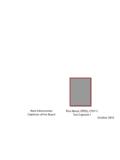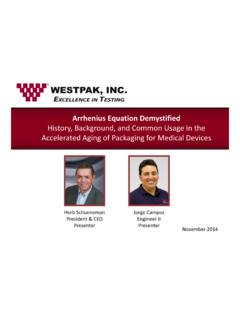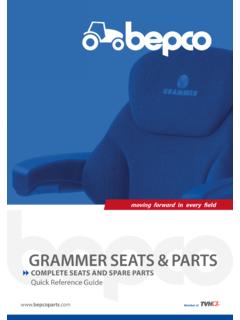Transcription of Cushion Engineering, design, and testing - Westpak
1 Cushion engineering , design AND testing PREPARED BY HERBERT H. SCHUENEMAN, CP-P/MH PRESENTED BY Westpak , INC. 83 Great Oaks Blvd., San Jose, CA 95119 (408) 224-1300 FAX (408) 224-5113 I. INTRODUCTION A Cushion or " Cushion system" is a protective medium that provides an interface between a fragile product and a potentially harmful environment. Primary "harmful" inputs to be considered here are shock and vibration. To protect a product from shock or impact, a Cushion will "translate" the high peak short duration shock signature that occurs when two rigid surfaces meet (such as a package dropping on a floor) into a low peak long duration shock pulse where the transmitted deceleration level is below the fragility level of the product (see Figure 1).
2 Figure 1 Figure 1 Cushioned Impact Input vs. Response Theoretical Time History - 1 - Figure 2 Package Vibration Response Attenuation Model For vibration protection the Cushion system must provide attenuation of vibration where frequencies known to be harmful to the product are reduced in amplitude before they reach the product. One possible method by which this would occur is represented graphically in Figure 2. Figure 3 Package Vibration Response Amplification Model The situation that must be avoided oc-curs when the product and package resonant frequencies coincide, resulting in an amplification of vibration input delivered through the Cushion to the product.
3 In this situation the protective package contributes to product damage and the product would likely be better off without the package. This is represented graphically in Figure 3. In general, the product and package must work together as a system to survive the distribution environment. It should also be noted that an optimum combination of product ruggedness and package protection will result in the lowest overall delivered cost of the product. Overly fragile products generally require very elaborate or expensive packages and will often experience high damage rates in - 2 - distribution.
4 Conversely, extremely rugged products generally cost more than necessary to survive the distribution environment, which for most products is the most severe environment they will encounter in their product life cycle (see Figure 4 for a graphic representation). We will now consider the background information necessary for Cushion design and engineering . Figure 4 Concept of a Protective Package - 3 - II. QUANTIFYING ENVIRONMENTAL INPUTS A prerequisite for package system design is a good understanding of the distribution environment from manufacturer to customer. This is when the package system performs its job. SHOCK OR IMPACT Most impacts occur during handling, especially the loading and unloading of transport vehicles.
5 The impacting of one vehicle against another (rail car coupling) also produces significant shocks. In general, defining the distribution shock environment amounts to quantifying the drop height likely to be experienced by the packaged product. The following generalities apply to package drop heights: 1. Most packages are subjected to many low level impacts while relatively few receive more than one "high" drop. (1) 2. Unitized loads are subject to fewer impacts and lower drop heights than individual packages. (2) 3. Most packages are dropped on their base. 50% or more of total impacts are base drops. (2) 4. The heavier the package, the lower the drop height.
6 (2) 5. The larger the package, the lower the drop height. (2) 6. Warning labels such as "Fragile" and "Handle with Care" have little effect on package handling. (2) 7. Handholds on the sides of packages appear to reduce the incidence of higher drop heights. (2) - 4 - The data used to define package drop height has recently come under question due to the introduction of more sophisticated measuring devices. Likely this area will change drastically in the future and the packaging engineer is encouraged to keep informed. Figure 5 Drop Height vs. Probability Data VIBRATION Defining the vibration distribution environment involves quantifying the acceleration vs.
7 Frequency profiles (spectra) of the vehicle types in which the product is shipped. These vibration inputs are random in nature and come from a variety of sources, such as roadbed, vehicle responses and others. However, certain types of vehicles such as trucks display higher density inputs in certain frequency bands. Similarly rail and aircraft have their own characteristic bands of highest density input. By measuring and compiling a large amount of data, "envelope" spectra can be established such as those taken from ASTM D4728 (4) which include frequencies likely from those vehicles. - 5 - Figure 6 Truck Spectra Envelope Spectra Both shock and vibration distribution data has been collected up to this point using instruments of limited accuracy.
8 The result may have been a conservative characterization of the environment. In addition, Overnight Delivery results in a more severe environment with a higher number of impacts and possibly a greater overall mean drop height (1). The availability of newer and more accurate instruments opens the possibility of better distribution environment characterization in the future. - 6 - - 7 - Figure 7 Envelope Spectra from ASTM D4728 (4) III. PRODUCT FRAGILITY (SUMMARY) MECHANICAL SHOCK The response of a package system to shock or impact can be easily quantified in the laboratory. However, the qualification of this response depends largely upon the product's ability to absorb mechanical shock.
9 In other words, one must first determine the fragility of the product to know if the cushioned response is adequate. Mechanical products are fragile because they can be broken or stressed beyond their limits. The typical method of determining stress resistance is Newton's classic formula: force = mass x acceleration (F = mA). Thus for a know product mass and a known force on the product, the upper acceleration limit can theoretically be determined. However, the DYNAMIC response of flexible elements (characterized as spring/mass systems) is very different than STATIC analysis normally used by product designers. This dynamic response characteristic can be easily seen when looking at the shock response spectrum (SRS) of a spring/mass system (Figure 8).
10 Depending on the nature of the input and other factors, the response of the system can be two or more times the level of the input. Thus the overall stress level can be substantially greater for dynamic inputs than for static forces. Other factors include the natural frequency of the responding system, the input frequency, and damping. - 8 - Figure 8 Shock Response Spectrum of a single degree of freedom undamped spring/mass system THEORETICAL SRS (SDOF) SHOCK RESPONSE SPECTRA VARIOUS PULSE SHAPES Resin/Input Frequency Ratio Single degree of freedom system No damping, linear spring Source: Shock & Vibration Handbook - Westpak DISK DRIVE SHOCK RESPONSE SPECTRA SHOCK RESPONSE SPECTRA GHI SYSTEMS, INC.















